Mastitis Disease in Cattle: Causes, Symptoms, and Treatment
Mastitis, also known as “Thnella Rog” in Hindi, refers to the inflammation or infection of the udder (mammary glands) in cattle. This disease occurs in four stages: Peracute, Acute, Subacute, and Chronic. Mastitis is primarily caused by bacterial infections, although it can also result from viruses, parasites, fungi, and other infectious agents.

This disease mainly affects cows, buffaloes, and goats, and is one of the most economically damaging diseases in the dairy industry. It typically manifests as painful swelling in the udder, along with milk that is clotted, foul-smelling, and discolored.
Mastitis Disease in Cattle
| Alternate Names |
|
|---|---|
| Causing Agents |
|
| Commonly Affected |
|
| Types |
|
| Main Symptoms |
|
| Transmission | Contact with infected milk, environmental contamination |
| Diagnosis Methods |
|
| Treatment |
|
| Prevention |
|
| Key Peculiarity | Chronic mastitis can lead to permanent milk production loss in affected udders |
| Learn more about Mastitis in Cattle: The Rajasthan Express | |
Prevalence and Economic Impact of Mastitis Disease in Cattle
Mastitis not only affects the health of cattle but is also a significant disease in the dairy industry, negatively impacting milk production, farmers’ income, and the national economy. When a cow or buffalo suffers from chronic mastitis in one udder, milk production from that udder permanently stops.

Subclinical Mastitis (SCM) and Chronic Mastitis are major challenges for the Indian dairy industry, causing an estimated annual loss of about ₹2.37 thousand crore. Subclinical Mastitis is more prevalent in India, accounting for approximately 70% of the total annual losses in the industry. The economic losses are greater in high-yielding crossbreeds (INR 1,314.10 per lactation) compared to native cows (INR 868.34) and buffaloes (INR 1,272.36).

Understanding the Types of Mastitis Disease in Cattle
Mastitis in cows and buffaloes is primarily caused by bacterial, viral, fungal, and parasitic infections. However, around 90% of mastitis cases in cows, buffaloes, sheep, and goats are bacterial in nature. Since mastitis can be caused by a variety of infectious agents (bacteria, viruses, fungi, and parasites), completely curing the disease can be very challenging.
- Bacterial Mastitis: Mastitis caused by bacterial infections, referred to as “Bacterial Mastitis.”
- Fungal Mastitis: Mastitis caused by fungal infections, referred to as “Fungal Mastitis.”
- Viral Mastitis: Mastitis caused by viral infections, referred to as “Viral Mastitis.”
- Parasitic Mastitis: Mastitis caused by parasitic infections, referred to as “Parasitic Mastitis.”
Etiology of Mastitis Disease in Cattle
Mastitis (Thnella Rog) is primarily caused by four types of infectious agents: bacteria, fungi, viruses, and parasites. Here is a detailed explanation of the various causes of this disease:
A. Bacterial Causes
Mastitis is mostly caused by bacterial infections and is commonly found in dairy animals such as cows, buffaloes, and goats.
- Environmental Mastitis: This type is primarily caused by bacteria like Klebsiella, Escherichia coli (E. coli), and Streptococcus uberis.
- Cold Mastitis: During the winter season, this disease is mainly caused by Leptospira Pomona bacteria.
- Summer Mastitis: In the summer, mastitis is caused by Corynebacterium pyogenes and Mycobacterium bovis bacteria.
- Contagious Mastitis: Contagious mastitis is primarily caused by Staphylococcus aureus and Streptococcus agalactiae bacteria.

Note:
- The most significant cause of mastitis in cows is Staphylococcus aureus.
- The second most common cause in cows is Streptococcus agalactiae.
Other bacteria that may contribute to mastitis include Pasteurella multocida, Streptococcus zooepidemicus, Streptococcus pyogenes, Brucella abortus, Klebsiella spp., Escherichia coli (E. coli), and Leptospira Pomona.
B. Fungal Causes
Fungal mastitis is caused by fungi such as Aspergillus fumigatus, A. midulus, Candida spp., and Trichosporon spp..
Common Symptoms of Mastitis Disease in Cattle
Mastitis can be classified into three types based on symptoms, each with distinct characteristics:
A. Acute Mastitis
- Severe swelling and painful tenderness in the udder.
- Extreme pain when the udder is touched.
- Mild fever in the animal.
- Milk production stops, but a thick secretion (yellowish and slightly reddish) starts to appear.
- The milk looks clotted, similar to curd, with the presence of dead cells and a yellow-brown color.
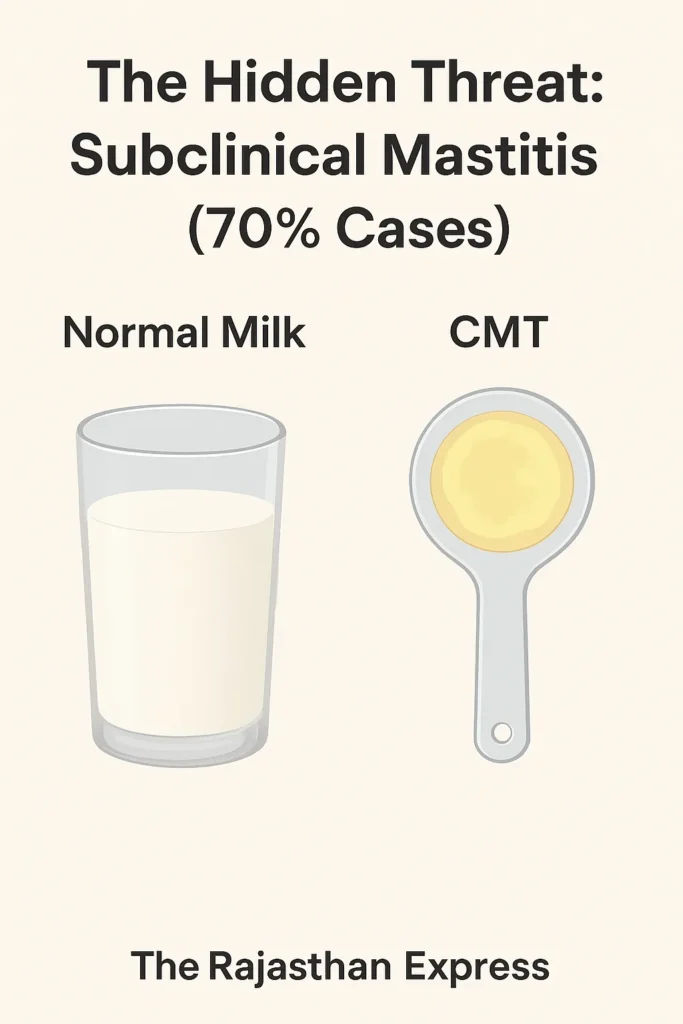

B. Sub-Acute Mastitis
- Mild swelling in the udder, but pain is manageable.
- The milk appears yellow, brown, or light red and looks like clotted curd.
C. Chronic Mastitis
- Pain when pressing on the udder due to fibrosis in the udder quarters.
- The milk is white-yellow, with possible clots and an unpleasant odor.
- This condition increases the likelihood of tuberculosis (TB) in the animal.
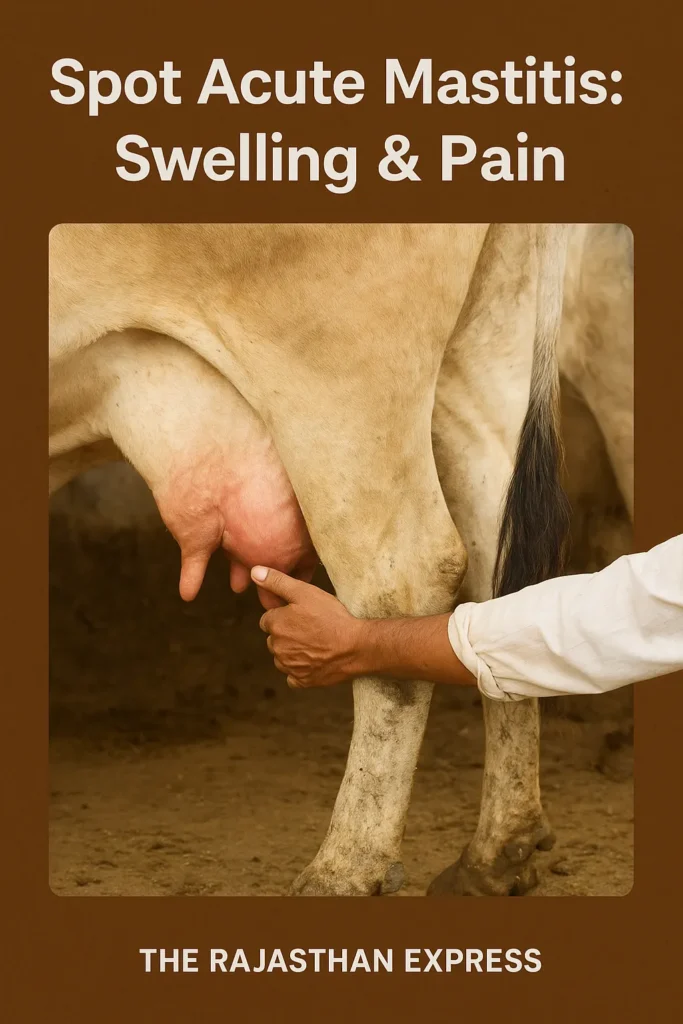
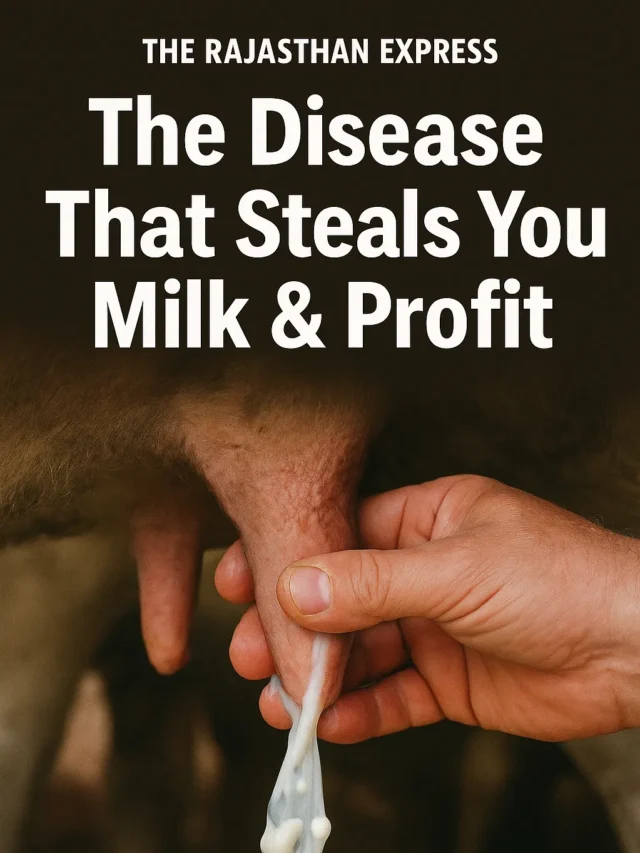
What Causes Mastitis in Dairy Cows?
Mastitis is more commonly seen in cows than in buffaloes, sheep, or goats, especially in foreign breeds. This is because the milk ducts of cows are wider compared to those of buffaloes. In native cows, mastitis generally occurs during the third lactation, while in foreign cows, it happens during the fifth lactation, as these animals produce the most milk during this period. Among foreign cows, Holstein-Friesian cows are the most affected by mastitis.

- Native Cow: 3rd Lactation
- Buffalo: 4th Lactation
- Foreign Cow: 5th Lactation
How to Diagnose Mastitis in Cattle
Mastitis is diagnosed based on the symptoms observed in the animal and various tests. Here are the primary methods used for diagnosing mastitis:
- By Symptoms: Mastitis can initially be detected by observing symptoms such as swelling, pain in the udder, changes in the color and texture of milk, or other related signs.
- California Mastitis Test (CMT): This is the simplest test for diagnosing mastitis. It checks for the somatic cell count in the milk.
Procedure: CMT solution is added to the milk sample, and the presence of a gel-like clot is observed. This test is also useful for detecting subclinical mastitis. - Chloride Test: This test checks for the chloride levels in the milk. In cases of mastitis, chloride levels in milk increase, causing the milk to become salty and separate when heated.
- Catalase Test: This test detects the presence of the enzyme catalase in the milk. Mastitis results in an increased amount of this enzyme in the milk.
- Bromo Cresol Purple Test: This test measures the pH level of the milk. During mastitis, the pH changes, turning the milk purple. In mastitis, the milk’s pH becomes alkaline.
- Bromothymol Blue Test: This test checks the acidity or alkalinity of the milk. If the milk turns blue or yellow, mastitis is confirmed.
- Strip Cup Test: This is a simple test where milk is collected manually in a filter cup. If mastitis is present, clots or color changes in the milk will be visible.

Effective Treatment for Mastitis in Cattle
A. Antibiotic Therapy for Mastitis: To prevent the spread of mastitis, infected animals should be isolated. All udders should be cleaned thoroughly to remove dead cells and yellow discharge. An antibiotic sensitivity test should be conducted to select the most effective antibiotics. After the test, administer the recommended antibiotic directly into the udder. Common antibiotics used in mastitis treatment include penicillin, streptomycin, and ceftriaxone. Antibiotic infusions should be applied once or twice daily to eliminate the infection effectively.
B. Types of Intramammary Infusions for Mastitis Treatment
- Antibiotic Intramammary Infusions: These infusions contain antibiotics like penicillin, streptomycin, and sulfa drugs. They are effective for treating bacterial mastitis by killing or inhibiting bacterial growth. However, if mastitis is caused by a virus, antibiotics will not be effective.
- Anti-inflammatory Intramammary Infusions: These infusions contain corticosteroids or flunixin meglumine, which help reduce inflammation and provide pain relief associated with mastitis.
- Combination Intramammary Infusions: Some infusions combine antibiotics and anti-inflammatory agents to achieve both antimicrobial and anti-inflammatory effects.
Example: Pendistrin SH
Composition:- Penicillin (Antibiotic Action)
- Streptomycin (Antibiotic Action)
- Sulfa Drugs (Antibiotic Action)
- Corticosteroid (Anti-inflammatory Action)
- Teat Sealant Intramammary Infusions: Teat sealants are used as infusions to prevent new infections in the udder. They are particularly used during the dry period (when milk production stops about two months before calving) to prevent mastitis.
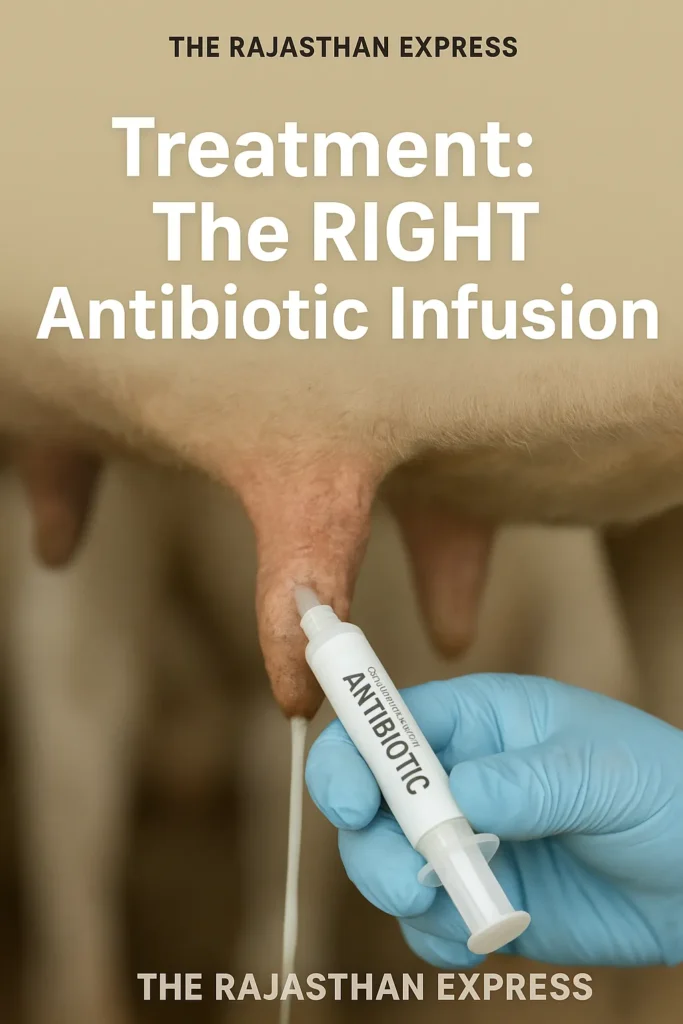
Preventive Measures for Mastitis in Cattle
- Maintain cleanliness on dairy farms and regularly disinfect all areas.
- Keep healthy animals separate from those infected with mastitis.
- Follow the “complete milking” method to prevent residual milk in the udders, as leftover milk increases the risk of infection.
- After milking, cows should not be allowed to stand for more than 2 minutes, and the udders should be cleaned thoroughly with warm water or an antiseptic solution.
- Spread sand in the barns, as it helps reduce the spread of infection compared to other flooring.
- Begin treatment immediately when symptoms of mastitis appear.
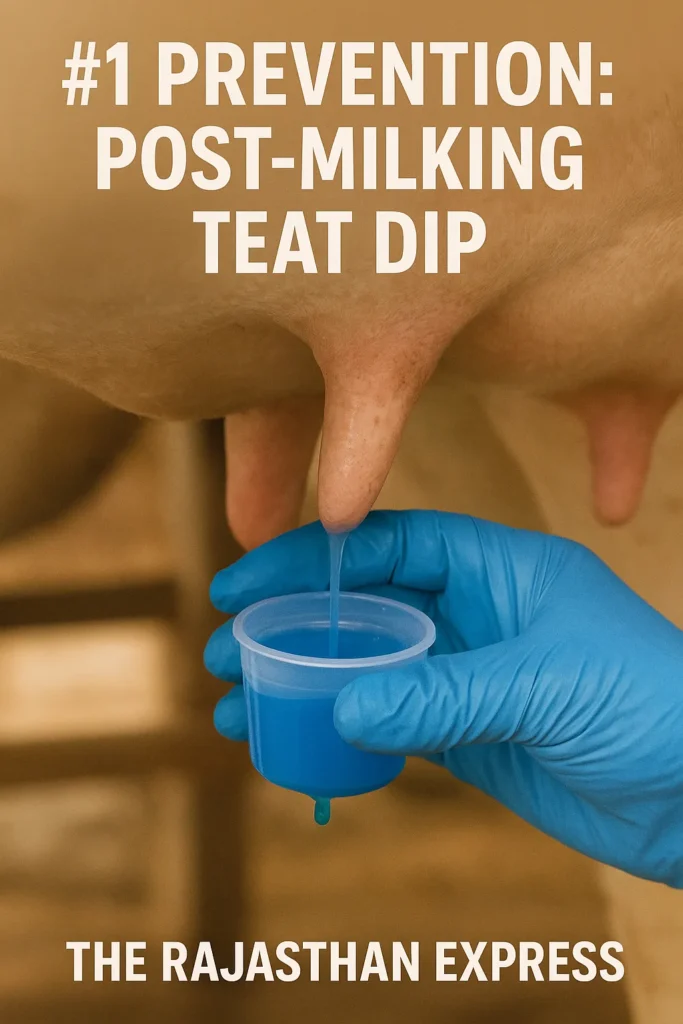

Clotted, watery milk? A swollen udder? Mastitis is costing Indian farmers ₹2,370 crore yearly. Learn to spot the 3 types, perform the simple CMT test, and apply the right antibiotic infusion to save your cow’s udder and your profit.
THE RAJASTHAN EXPRESS
People also ask ?
What Causes Mastitis in Dairy Cows?
Mastitis is primarily caused by bacterial, viral, parasitic, and fungal infections. The main culprits are bacteria, such as Staphylococcus aureus and Streptococcus agalactiae, which spread the infection.
How is Mastitis in Cattle Treated?
Mastitis is treated using antibiotics like penicillin, streptomycin, and ceftriaxone. Infected cows are isolated, and their udders are cleaned. Intramammary antibiotic infusion is also used.
What Are the Three Types of Mastitis?
There are three main types of mastitis:
1.Acute Mastitis – Severe swelling and pain.
2. Sub-Acute Mastitis – Mild swelling and pain.
3. Chronic Mastitis – Long-term swelling and pain due to fibrosis.Which Antibiotic is Best for Mastitis?
Penicillin, streptomycin, and ceftriaxone are effective antibiotics for treating mastitis. The correct antibiotic is selected after an antibiotic sensitivity test.
What is the pH of Milk During Mastitis?
During mastitis, the milk becomes alkaline, which is a change from the normal milk and can appear purple in color.
What is Mastitis in Cows?
Mastitis, or udder disease, is an infection or inflammation of the cow’s udder, typically caused by bacteria, viruses, or fungi. This condition affects the quality of milk and reduces milk production.
How is Mastitis Controlled in Livestock?
Mastitis in livestock is controlled through antibiotic treatment, cleaning of the udders, and isolating infected cows. Intramammary infusion and antibiotic sensitivity tests are also important measures.
How Can Mastitis in Cows be Diagnosed?
Mastitis can be detected through symptoms (such as swelling, pain, and changes in milk color) and various tests, including the California Mastitis Test, Chloride Test, and Catalase Test.
What Tools Are Used to Test Milk for Mastitis?
Tools and tests used to detect mastitis in milk include the California Mastitis Test (CMT), Chloride Test, and Bromo Cresol Purple Test. The CMT is the most common and simple method.






